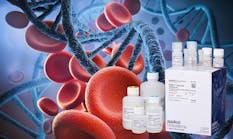The Centers for Disease Control and Prevention (CDC) estimates that there are between 9.2 and 35.6 million influenza cases each year in the United States. These cases lead to between 140,000 and 710,000 hospitalizations, with 12,000 to 56,000 deaths.1 Symptoms of influenza and pneumonia can have significant overlap, making diagnosis based on clinical presentation challenging. Various diagnostic tests for influenza are available in support of the goal of identifying patients to whom an antiviral should be administered, or determining whether non-viral etiologies should be further investigated.
Since antiviral treatment is effective only if begun within the first 48 hours of symptom onset, test results must be available within a narrow window. Furthermore, influenza is highly infectious. As part of infection control, a prompt diagnosis helps to minimize the exposure time of influenza-positive patients with other patients and the medical staff. In that context, many clinicians rely on clinical presentation alone to diagnose influenza; however, studies have shown that the clinical diagnosis of patients based on symptoms alone is not sufficiently accurate.2
The traditional standard for influenza testing, viral culture, is a labor-intensive and time-consuming method. Traditional culture requires four to five days to generate a result and is, therefore, not fast enough to impact therapy decisions. “Shell vial” culture reduces the time to result to two to three days, but that is still not an adequate timeframe to affect what is happening on a patient level. Fluorescent microscopy can be done same-day, but it is labor-intensive and not done on a stat basis. In many cases, the complexity of viral culture overall has resulted in hospitals moving this testing to reference laboratories.
Lateral flow tests
Lateral flow assays for influenza, also known as rapid influenza diagnostic tests (RIDTs), were developed to reduce the reliance on culture. Lateral flow tests are relatively easy to perform and affordable, making them suitable for use in a variety of settings from laboratories to near-patient. They also typically provide results in minutes, allowing medical professionals to include the results of an objective test in their clinical decision making. The specificity of lateral flow tests is sufficiently high so that additional confirmatory testing is not necessary with a positive result. Published data show that a positive rapid lateral flow influenza test can have a direct impact on patient care by shortening the time to treatment and reducing unnecessary use of antibiotics, as well as providing downstream health and cost savings associated with minimizing the need for ancillary testing such as chest x-rays and blood and sputum culture, and reducing hospitalizations and length-of-stay.3-5
The challenge with lateral flow assays is that they do not provide the desired sensitivity. This became increasingly apparent in 2009 when novel H1N1 influenza spread throughout the world.6 The low sensitivity resulted in an unacceptable level of false negative tests for H1N1 that was often detected later with confirmatory testing. Many laboratories began to shift from lateral flow assays to molecular testing known to provide significantly higher sensitivity while maintaining or improving specificity. With a molecular assay, no additional testing is usually needed; however, the trade-off is time to result, which can be more than an hour. In the event of a large influx of patients, it can take hours from sample collection to the time results are reported. In using a molecular influenza test, many laboratories are able to turn out highly sensitive and specific results, but with minimal impact on patient care, as many doctors treat empirically rather than waiting for test results.
Today, the next generation of molecular assays is focused on combining the ease of use and speed of traditional lateral flow assays with the accuracy of molecular amplification. The newer rapid molecular platforms can be smaller and faster, and can be brought closer to the patient, with the hope for improved clinical impact.
Rapid molecular testing
Rapid molecular assay technology involves taking the sample and lysing the viral membranes to expose the RNA. The RNA is converted into DNA through reverse transcriptase and then amplified. The amplification technique that is used varies by molecular technology. Techniques include polymerase chain reaction (PCR), which uses thermocycling—a series of temperature changes—or enzymatic technologies, which rely on enzymes rather than heating and cooling to open the DNA helix. The amplification step gives molecular tests an advantage in sensitivity as compared to lateral flow by creating billions of copies of the DNA to increase the amount of detectable influenza virus in the sample.
Rapid molecular influenza test results are now available in as little as 13 minutes and several are CLIA-waived, making highly sensitive rapid molecular testing accessible for clinics and physician offices. Some hospitals are setting up satellite point-of-care locations to better triage potentially infectious patients so the results can be available at time of patient evaluation, there is less risk of exposure and transmission, and the results can
affect treatment decisions. The cost of rapid molecular tests is higher than lateral flow, but that may be offset by helping to improve antibiotic stewardship to reduce antibiotic resistance and rates of C difficile, reducing the need for ancillary tests, and potentially limiting unnecessary admissions and reducing length of stay.
Some caveats apply with regard to influenza testing. Even though molecular assays have better clinical sensitivity, it is still imperative that good clinical samples be collected. Even the most sensitive influenza test run by the most skilled laboratorian cannot fully overcome poor sample collection. Additionally, influenza tests are not typically run year-round. While specificity may remain good for these assays, the positive predictive value (the probability that a patient with a positive influenza result actually has the disease) will fall dramatically when there is no influenza circulating. Sites like the CDC’s publish the influenza surveillance updates, which include activity maps and information on subtypes and vaccines.
REFERENCES
- Centers for Disease Control and Prevention. Disease burden of influenza. https://www.cdc.gov/flu/about/disease/burden.htm.
- Blaschke AJ, Shapiro DJ, Pavia AT, et al. A national study of the impact of rapid influenza testing on clinical care in the emergency department. J Ped Infect Dis. 2014;3(2):112-118; doi: 10.1093/jpids/pit071.
- Bonner AB, Monroe KW, Talley LI, Klasner AE, Kimberlin DW. Impact of the rapid diagnosis of influenza on physician decision-making and patient management in the pediatric emergency department: results of a randomized, prospective, controlled trial. Pediatrics. 2003;112(2):363-367.
- Williams KM, Jackson MA, Hamilton M. Rapid diagnostic testing for URIs in children: impact on physician decision making and cost. Infect Med. 2002:19(3):109-111.
- Blaschke AJ, Shapiro DJ, Pavia AT, et al. A national study of the impact of rapid influenza testing on clinical care in the emergency department J Ped Infect Dis. 2014:3(2):112-118; doi:10.1093/jpids/pit071.
- Ginocchio CC, Zhang F, Manji R, et al. Evaluation of multiple test methods for the detection of the novel 2009 influenza A (H1N1) during the New York City outbreak. J Clin Virol. 2009;45(3):191-195.
Norman Moore, PhD, is a microbiologist and director of scientific affairs for Alere. Moore has six patents in the diagnostic field and is the inventor of such tests as the rapid urinary antigen for Legionella and S. pneumoniae. He works on multiple medical committees and gives educational lectures around the globe.






